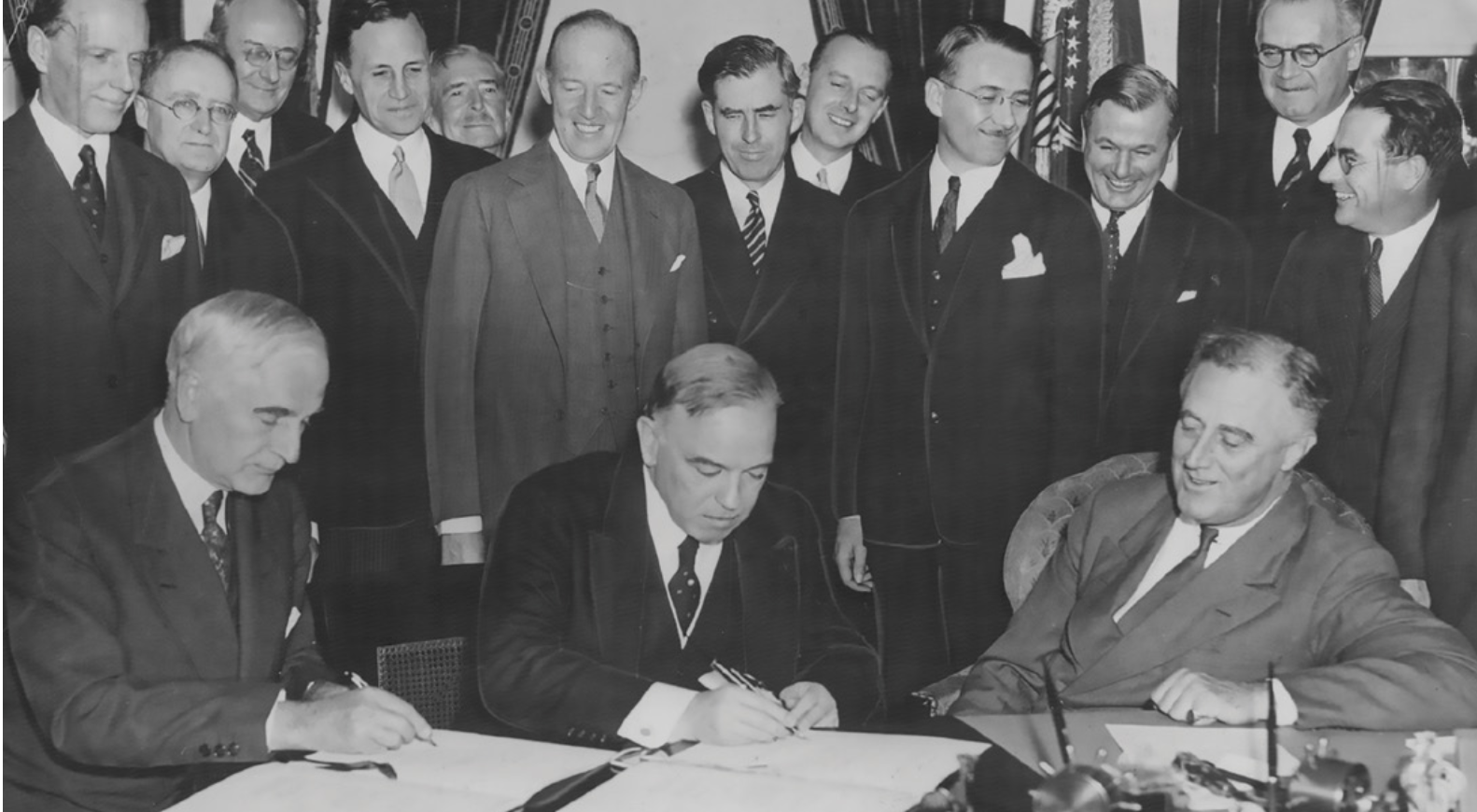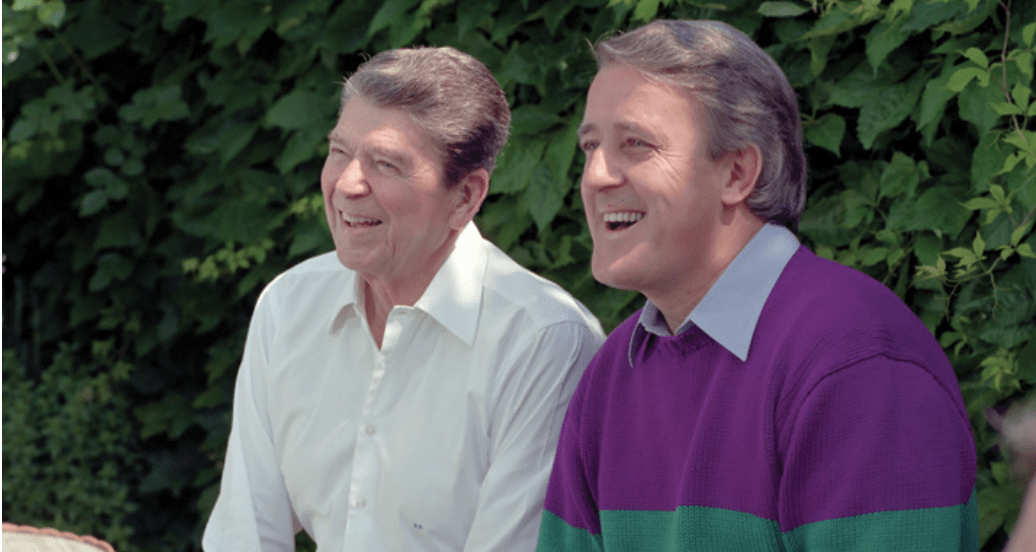Prime Ministers and Presidents: What Defines a ‘Good Relationship’?
As Policy readers know, there have been famously discordant bilateral relationships at the prime ministerial-presidential level. But what defines a successful dynamic between Canadian and American leaders? Historian J.D.M. Stewart looks at what has worked and what hasn’t in our long, cross-border tango.
J.D.M. Stewart
The history of the relationships between the prime ministers of Canada and presidents of the United States has been a subject of deep political interest, analysis, and investigation since Sir John A. Macdonald went to Washington in 1871 and came home with a treaty of the same name. In bilateral politics, there are no two bigger stars than the president and prime minister. From the Canadian perspective, meetings between the two leaders take on a Hollywood feel, with white-hot media attention on every detail. Whether the bilateral spotlight is shining in Ottawa or Washington—or even Quebec City—the success or failure of the relationship between the leaders is of vital importance in this country.
While the relationship gets plenty of attention, it is also a very challenging one for the prime minister to negotiate. Not only is he dealing with the most powerful man on the planet, but the PM must also pay attention to an abiding attitude of anti-Americanism in this country. Prime Minister Lester Pearson cautioned in his memoir: “We should resist any temptation to become smug and superior: ‘You are bigger but we are better.’ Our own experience, as we wrestle with our own problems, gives us no ground for any such conviction.” Balancing all of this takes great skill.
There are distinct commonalities, however, among the most successful prime ministers in their relationships with the president. The most important one is the personal rapport with the man in the Oval Office. Carleton University professor Fen Osler Hampson put it well in his 2018 book Master of Persuasion:
“There is no more exacting test for the leadership mettle of any Canadian leader than the way relations with the United States are managed. Personal relationships count, especially in Washington.”
Few prime ministers have understood or cultivated ties with American leaders better than Brian Mulroney. His relations with both President Ronald Reagan and George H. W. Bush were intimate and enduring. It was no surprise that Mulroney was asked to give eulogies at both men’s funerals. Mulroney knew that everything began with personal diplomacy.
“Having established a relationship of friendship, trust, and mutual respect with the president of the United States,” he wrote in his 2008 memoir, “Canada’s leader is uniquely qualified, through ongoing private dialogue, to influence decisions that ensure that America does not use its power ‘like a giant.’” Reagan and Mulroney were particularly close. “These two Irishmen are going to get along like blazes,” noted Canadian ambassador, Allan Gotlieb, in 1984 after their first meeting. “There is a special rapport between them… They established a very special relationship.”

Mackenzie King, who placed second in the Policy ranking, was very close to President Franklin D. Roosevelt, the two Harvard men’s tenures overlapping for ten years from 1935 to 1945. The duo had real affection for one another, with Roosevelt calling King “Mackenzie” (King too deferential to tell the president that his close friends referred to him as “Rex”), while the prime minister very much enjoyed his time alone with the president and spoke warmly of FDR both in public as well as in his diaries. In 1941, during the dark days of the Second World War, FDR wrote in a letter to King that “It is a grand and glorious thing for Canada and the United States to have the team of Mackenzie and Roosevelt at the helm in days like these. Probably both nations could get along without us but I think we may be pardoned for our thoughts, especially in view of the fact that our association so far has brought some proven benefits to both nations.”
Just as relationships between PM and President can be warm and genuine, they can also be frosty and perfunctory. Prime Ministers Pierre Trudeau and John Diefenbaker fared poorly in the Policy ranking. Their prickly interactions with presidents played a significant role. There was a reciprocal disdain between President John F. Kennedy and Diefenbaker, whose time in office aligned from 1961 to 1963. “Not only are there substantial differences in policy involved,” noted Charles Ritchie in his diary, whom the Chief named as ambassador to the United States in 1962, “but the atmosphere is poisoned by the mutual aversion of the Prime Minister for the President and the President for the Prime Minister.” Kennedy viewed Dief, “as a mischief-making old man who cannot be trusted” while the latter viewed the former “as an arrogant man and a political enemy.”
Trudeau, meanwhile, in 1971, was referred to as an “asshole”, “pompous egghead” and “son of bitch” by President Richard Nixon, per leaked memos and White House tapes released later. Things were not much better in the early 1980s when Reagan took office. The prime minister was “a pariah at the White House,” according to Gotlieb’s diaries. “Trudeau’s blown his relationship with Reagan, and it’s dangerous times for us,” he recorded in 1982.

Cozying up to the president and achieving bilateral agreements is not the only measure of a strong relationship with the United States. Canadians also want a prime minister who will continue to exert the country’s sovereignty. It is not easy to be a neighbour to the world’s most powerful country, and finding the right balance of friendship and resistance takes talent. Prime Minister Jean Chrétien (third in the ranking) used to say he would not fish with the president because he did not want to end up as the fish—a reference to Brian Mulroney’s close relationship with George H.W. Bush, which included fishing excursions off of the Bush family compound in Kennebunkport, Maine. Professor John Kirton of the University of Toronto labelled it the “Doctrine of No Fishing.”
While Chrétien would go on to golf with President Bill Clinton dozens of times during their overlap from 1993 to 2001, he also knew, as the most successful prime ministers do, how to say “No” to a president. Perhaps the best example of this was Chrétien’s 2003 refusal to participate in George W. Bush’s Iraq War. Speaking in the House of Commons on April 8 of that year, he said:
The decision we made three weeks ago was not an easy one at all. We would have preferred to have been able to agree with our friends but we, as an independent country, make our own decisions based on our own principles, such as our longstanding belief in the value of a multilateral approach to global problems.
Chretien’s decision was a courageous one, the type Canadians appreciate. A poll conducted in 2003 by the Toronto Star found that seven out of 10 Canadians supported the decision and years later the former prime minister recalls it as one of his defining moments.
While many may recall Mulroney’s tenure as having only harmonious relations with the US, he did stand up to them as well. In 1988, after negotiations over Canada’s sovereignty over the Northwest Passage fizzled, Mulroney told Reagan that Canadians owned it, “lock, stock and icebergs.” He declined to join the President’s Strategic Defense Initiative—commonly known as Star Wars—and pushed him hard on acid rain, famously giving Reagan’s vice president, George H. W. Bush, “an earful” after a 1987 meeting on the topic at 24 Sussex Drive.
Standing up to the President can have its consequences, however. Prime Minister Lester Pearson delivered a 1965 speech at Temple University in Philadelphia critical of US policy on the Vietnam War. President Lyndon Johnson was not amused. Charles Ritchie, the Canadian ambassador, described LBJ’s reaction as “sulphurous.” When Pearson later arrived at Camp David to meet the president the reception was icy.
Johnson, in a famously profanity-filled tirade, grabbed the Nobel Prize-winning PM by his lapels and growled “You don’t come into my living room and piss on my rug!” “The relationship between the two men never recovered,” Ritchie wrote in his diaries, published in 1983 as Storm Signals.
Personal rapport is essential, exerting sovereignty is desirable, but it’s the results that last. The most effective prime ministers can cite tangible achievements with the United States as part of their legacy. Mulroney’s 1988 Free Trade Agreement and the 1991 Acid Rain Treaty (officially the Air Quality Agreement) are two significant banners to show for his work with American presidents.
Mackenzie King can boast of the Permanent Joint Board on Defence that resulted from the Ogdensburg Agreement of 1940; he and Roosevelt also penned the Hyde Park Declaration of 1941 that cemented the economic ties between the two countries and was central to providing war materiel to the British and other allies at a crucial moment during the Second World War. Historian Tim Cook called it “King’s monumental victory.” Lester Pearson had the 1965 Auto Pact. Louis St Laurent, fourth in the Policy ranking, efficiently got things done. The leadership he showed in his relationship with both Harry Truman (cordial but not warm) and Dwight Eisenhower (golfing buddies) led to the signature bilateral achievement of the St. Lawrence Seaway, on which construction began in 1954. Bilateral agreements for the DEW Line and NORAD were also significant. The leaders behind these achievements were usually able to parlay their special status and powers of persuasion to get results for Canada.
The job of handling Canada-US relations is not an easy one, but it is the most important foreign affairs responsibility of the Prime Minister of Canada. “This is not a matter that a prime minister can delegate to a member of cabinet,” wrote Mulroney. Successful Canadian leaders have used their personal rapport to get results. At the same time, they usually found the right balance of cooperation and resistance when dealing with our powerful neighbour to the south. Through all of the ups and downs, Canada and the United States will remain, in the words of Carleton professor Norman Hillmer’s 1989 book about the two countries, “partners nevertheless.”
J.D.M. Stewart has been teaching Canadian history for 27 years. He is also a writer who has been chronicling Canada’s history in newspapers and magazines for more than 30 years. His critically acclaimed book, Being Prime Minister, was published by Dundurn in 2018.
